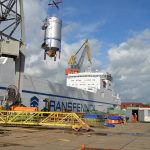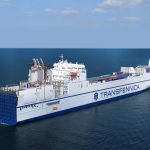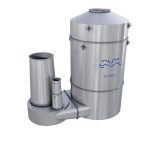In 2012, the largest SOx scrubber was installed on ConRo vessel »Plyca«, operated by Transfennica of dutch Spliethoff Group. This will now be repeated five times over as sister vessels are retrofitted with Alfa Laval’s PureSOx
Spliethoff Group is one of the largest ship management companies in the Netherlands, possessing a leading role in the world[ds_preview] transport market for forest products, heavy-lift cargo, general cargo and yachts. The company operates a modern fleet of over 100 ice-classed vessels, ranging in size from 2,100 to 23,000t.
Among those vessels is the »Plyca«, a ConRo vessel that boasts the world’s largest SOx scrubber: a multi-inlet Alfa Laval PureSOx system serving two Wärtsilä main engines of 12.6 MW each, as well as two auxiliary engines of 1.36 MW each. Installed in 2012, the scrubber has a hybrid configuration, allowing it to operate both in open-loop mode (seawater) and in closed-loop mode (fresh water).
As January 2015 and the enforcement of SOx limits in Emission Control Areas (ECAs) approach, Spliethoff is now retrofitting an additional five ConRo vessels with similar PureSOx systems. Like the »Plyca«, the »Genca«, »Kraftca«, »Timca«, »Trica« and »Pulpca« are operated by Spliethoff Group member Transfennica. Each will use a single PureSOx scrubber to handle four engines totalling 28 MW, with an exhaust gas mass flow of 132,000 kg/h.
Acting on fuel cost concerns
The new retrofits are a bold second move for Spliethoff, being made as many other ship owners are just making their first. »The order books of the major scrubber suppliers are suddenly filling up,« says Frank Louwers, Director of Spliethoff Group. »Many ship owners have been waiting and waiting, but now having arrived in 2014, it seems they’re finally starting to act.«
Without a doubt, the increased activity marks a realization that MGO will soon be a necessity for many vessels. Concerns about the cost are high among Baltic Sea shippers, especially in Finland, which is a primary destination for Transfennica. Transfennica offers a number of frequent RoRo services to and from Finland, including daily sailings between Lübeck and Hanko.
»Finland can essentially be considered an island, since nearly all export and import occurs by sea,« says Louwers. »This makes any rise in fuel costs sensitive, and it’s uncertain what surcharge ship owners will have to apply as of January next year. The future demand for MGO is unknown, along with the future price.« In this respect, the use of scrubber systems gives Transfennica customers a certain stability when it comes to fuel surcharges.
Waiting was never an option
Louwers sees scrubbers as an important buffer against rising fuel costs. By enabling the continued use of HFO, they prevent full dependence on the MGO market. Yet why did Spliethoff install the largest scrubber in the world, a full three years before the onset of regulations? »If you wait until December 2014 to think about what you’re going to do, you’re going to be too late,« Louwers explains. »Our philosophy has always been to move, rather than to sit back and wait.«
In Louwers’ opinion, Splietfhoff’s head start with the »Plyca« was a matter of practicality. The company knew it would take time to investigate technologies and to get a solution installed. Moreover, Spliethoff wanted time to evaluate the solution before installing it on subsequent vessels. »We had to start early, because we wanted a full year to test the system aboard the Plyca before installing others,« he says. »Since we wanted the rest by 2015, we simply counted backwards. We knew what schedule we had to work with.«
Every alternative considered
Although Spliethoff’s timeframe was clear from the beginning, the choice of PureSOx or even a wet scrubber was not. In addition to wet scrubbers, the company considered both LNG and dry scrubber technology.
When it came to LNG, cost was the prohibitive factor. »The total cost was immense – much more than the scrubber alternative,« says Louwers. »Plus there were the huge LNG tanks that would have confiscated many square metres of cargo space.« However, Louwers foresees a future for LNG, »provided the infrastructure grows and the LNG price becomes competitive enough to justify the higher building cost.«
Less convincing was the option of a dry scrubber, despite its apparent ease of operation. »The equipment is huge and heavy, and we weren’t persuaded that the predicted costs were realistic,« Louwers says. »Plus we would be dependent on the supplier, and we didn’t feel certain about the availability of the granulates.«
The choice of Alfa Laval and PureSOx
What did feel certain to Spliethoff, after thorough investigation, was the choice of a hybrid wet scrubber. Although open-loop systems were initially considered, they were eventually rejected in favour of hybrid flexibility. »Open-loop systems are easy and less expensive to operate, and the system layout itself is cheaper,« says Louwers, »but the hybrid gave us option to sail in closed-loop mode at any time, without having to go through a reinstallation or modification.«
After seeing PureSOx aboard the DFDS »Ficaria Seaways«, Spliethoff was also convinced that a major supplier was the most feasible alternative. »We decided that we wanted to work with a big company, not some new magician developing a system out of the blue,« Louwers recalls. »We knew Alfa Laval couldn’t just put a system on the market without it working, and the number of experience suppliers at the time was very limited.«
PureSOx on the »Ficaria Seaways« was smaller and simpler than what was required on the »Plyca«, serving only one engine of 21 MW. However, Spliethoff was content with Alfa Laval’s knowledge and the willingness to share it. »What we saw on the Ficaria met our expectations, and Alfa Laval was well informed,« says Louwers. »The offer and the system capabilities felt realistic, so we decided that PureSOx was the best solution for the Plyca.«
From selection to realization
With PureSOx selected, Spliethoff’s focus shifted to the immense challenge of getting the system on board. The »Plyca’s« arrival at the shipyard was ambitiously scheduled for 26 September 2012, a date coinciding with the vessel’s regular docking.
A SOx scrubber had never been installed on the »Plyca’s« scale, let alone one to serve four engines. Plans were made for every detail, from the prefabrication of parts and housings to the logistics of getting it all into place. Besides a scrubber room next to the existing funnel, an auxiliary room would to be built for the freshwater tanks and the water cleaning unit, along with additional walkways, handrails and maintenance platforms.
The work was coordinated by Spliethoff’s own engineers, with dedicated support from Alfa Laval. By the time the »Plyca« arrived at the shipyard, all was prepared and the work of removing and repositioning existing equipment could begin. In just four weeks the »Plyca« was ready for the commissioning of the PureSOx scrubber, which became fully operational on 1 November 2012.
PureSOx performance at sea
Since setting sail with PureSOx, the »Plyca« has logged around 14,000 hours of continuous scrubber operation. Following a month of closed-loop testing at sea in cooperation with Alfa Laval, the vessel has made full use of the system’s hybrid capabilities, operating it in open-loop mode at sea and in closed-loop mode mainly in port.
In terms of the system’s performance, Louwers is unswervingly positive. »PureSOx has operated 24 hours a day, 365 days a year,« he says. »The Plyca has been running it with no stops or failures, and without ever exceeding the limits for air emissions and discharge.«
Regarding water discharge, Louwers commends the stability of the PureSOx water cleaning unit, which uses centrifugal separation to process the water in closed-loop mode. »Once some initial technical issues were resolved, the water cleaning unit has operated very reliably,« says Louwers. »We don’t hear the same news about gravity-based systems, as separation by gravity on a moving vessel can be a challenge. The rotating purifier is a trustworthy solution.«
Re-evaluating the scrubber market
Given its performance aboard the »Plyca«, PureSOx might seem the obvious choice for Spliethoff’s five other ConRo vessels. Yet in keeping with the company’s thorough approach, this was not the case.
»Our course of action was clearer this time, in that we knew we wanted a hybrid system,« Louwers explains. »Even so, new makers have entered the market since 2012, so we took in quotes from five suppliers. After making an extensive and detailed comparison of the various systems and offers, we decided that Alfa Laval would still suit us best.«
The next step for Spliethoff was to select a shipyard for the upcoming retrofits. This time the contract fell to the German Dry Docks in Bremerhaven, which offered the capacity and capabilities needed for five scrubber installations in tight succession between July and December 2014. »German Dry Docks made us a clear and attractive offer, and they were able to give us the flexibility we requested,« says Louwers. »We needed a large area, multiple production facilities, multiple docks, good crane capacity and good storage capacity. Because we’re installing five scrubbers in turn, we need to be able to store and protect them until each is ready to go on board. So far, everything seems possible in Bremerhaven.«
Best practice in the new installations
When it comes to the retrofit process, Spliethoff will once again be directly involved. »There are some suppliers who offer turnkey solutions, where you drop off the ship and they hand it back with a scrubber,« Louwers says, »but we prefer to be in control of the entire process and to select the sub-suppliers ourselves.«
Although the equipment and procedures will be similar to those for the »Plyca«, there will be some important differences, which Spliethoff hopes will further shorten the installation time. Before, the scrubber components were lifted in and installed separately, after which a housing was hoisted on board. This time, the housing will be installed as a complete prefabricated unit, with all of the scrubber components already inside. In addition, the pumps on »Plyca’s« sister vessels will be installed in a separate enclosure, located in front of the engine room. »On the Plyca there was a lot of rearranging and rebuilding that had to be done in the engine room,« says Louwers. »The new placement will give us easy access with only limited impact on the engine room itself, which will speed up the installation.«
According to Louwers, the first deliveries have been made and shipyard is well underway with the prefabrication process. »Everything is running fine so far,« he says. »German Dry Docks is fulfilling our expectations.«
Spreading the scrubber message
When the five retrofits are completed, Spliethoff will have broken ground not only in terms of scrubber size, but also in terms of installation scope. This means the company is likely to receive even more visit requests than it does today.
»When we take people aboard the Plyca, we point out that the hybrid is very easy to use,« says Louwers, who stresses the importance of seeing a solution in reality. »A scrubber is a huge installation with complex piping. But when people see it on board, it’s surprisingly easy to follow. Seeing it makes it easier to understand and to make the jump from drawings to real life.«
In Louwers’ opinion, this understanding is of vital importance as 2015 and SOx limits approach. »There are still people in the industry who say scrubbers won’t work, but that’s a sentiment we definitely don’t support,« Louwers says. »Our experience shows that they work, and we’re happy with the system we have on board.«
René Diks, Klaus Maak























